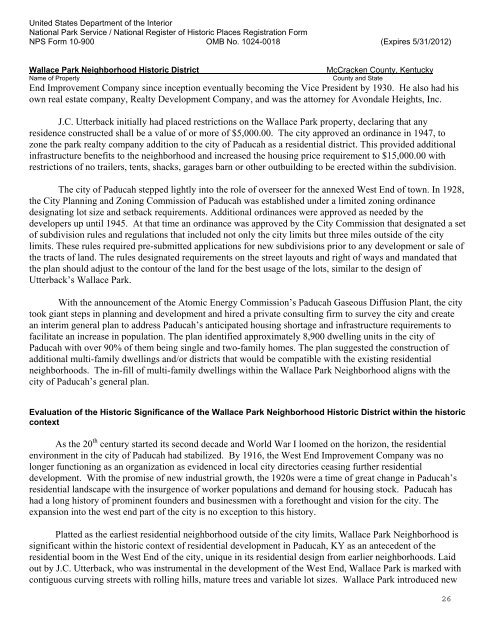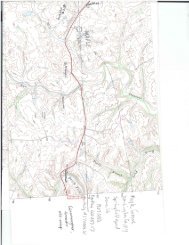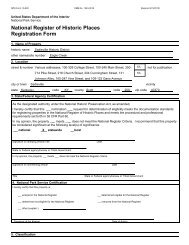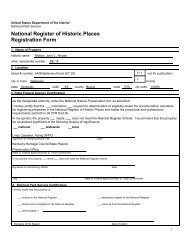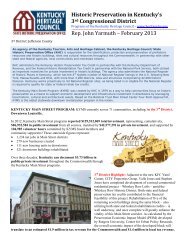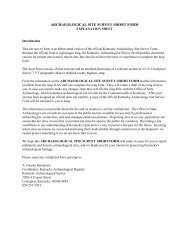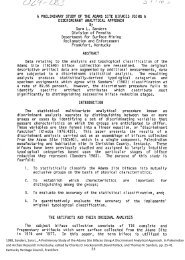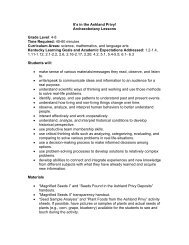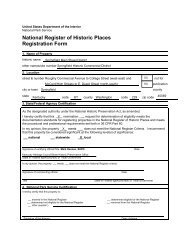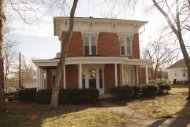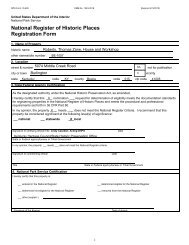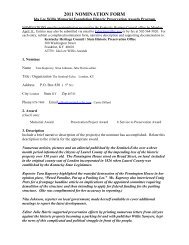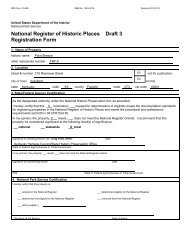Wallace Park Neighborhood Historic District - Kentucky: Heritage ...
Wallace Park Neighborhood Historic District - Kentucky: Heritage ...
Wallace Park Neighborhood Historic District - Kentucky: Heritage ...
You also want an ePaper? Increase the reach of your titles
YUMPU automatically turns print PDFs into web optimized ePapers that Google loves.
United States Department of the Interior<br />
National <strong>Park</strong> Service / National Register of <strong>Historic</strong> Places Registration Form<br />
NPS Form 10-900 OMB No. 1024-0018 (Expires 5/31/2012)<br />
<strong>Wallace</strong> <strong>Park</strong> <strong>Neighborhood</strong> <strong>Historic</strong> <strong>District</strong> McCracken County, <strong>Kentucky</strong><br />
Name of Property County and State<br />
End Improvement Company since inception eventually becoming the Vice President by 1930. He also had his<br />
own real estate company, Realty Development Company, and was the attorney for Avondale Heights, Inc.<br />
J.C. Utterback initially had placed restrictions on the <strong>Wallace</strong> <strong>Park</strong> property, declaring that any<br />
residence constructed shall be a value of or more of $5,000.00. The city approved an ordinance in 1947, to<br />
zone the park realty company addition to the city of Paducah as a residential district. This provided additional<br />
infrastructure benefits to the neighborhood and increased the housing price requirement to $15,000.00 with<br />
restrictions of no trailers, tents, shacks, garages barn or other outbuilding to be erected within the subdivision.<br />
The city of Paducah stepped lightly into the role of overseer for the annexed West End of town. In 1928,<br />
the City Planning and Zoning Commission of Paducah was established under a limited zoning ordinance<br />
designating lot size and setback requirements. Additional ordinances were approved as needed by the<br />
developers up until 1945. At that time an ordinance was approved by the City Commission that designated a set<br />
of subdivision rules and regulations that included not only the city limits but three miles outside of the city<br />
limits. These rules required pre-submitted applications for new subdivisions prior to any development or sale of<br />
the tracts of land. The rules designated requirements on the street layouts and right of ways and mandated that<br />
the plan should adjust to the contour of the land for the best usage of the lots, similar to the design of<br />
Utterback’s <strong>Wallace</strong> <strong>Park</strong>.<br />
With the announcement of the Atomic Energy Commission’s Paducah Gaseous Diffusion Plant, the city<br />
took giant steps in planning and development and hired a private consulting firm to survey the city and create<br />
an interim general plan to address Paducah’s anticipated housing shortage and infrastructure requirements to<br />
facilitate an increase in population. The plan identified approximately 8,900 dwelling units in the city of<br />
Paducah with over 90% of them being single and two-family homes. The plan suggested the construction of<br />
additional multi-family dwellings and/or districts that would be compatible with the existing residential<br />
neighborhoods. The in-fill of multi-family dwellings within the <strong>Wallace</strong> <strong>Park</strong> <strong>Neighborhood</strong> aligns with the<br />
city of Paducah’s general plan.<br />
Evaluation of the <strong>Historic</strong> Significance of the <strong>Wallace</strong> <strong>Park</strong> <strong>Neighborhood</strong> <strong>Historic</strong> <strong>District</strong> within the historic<br />
context<br />
As the 20 th century started its second decade and World War I loomed on the horizon, the residential<br />
environment in the city of Paducah had stabilized. By 1916, the West End Improvement Company was no<br />
longer functioning as an organization as evidenced in local city directories ceasing further residential<br />
development. With the promise of new industrial growth, the 1920s were a time of great change in Paducah’s<br />
residential landscape with the insurgence of worker populations and demand for housing stock. Paducah has<br />
had a long history of prominent founders and businessmen with a forethought and vision for the city. The<br />
expansion into the west end part of the city is no exception to this history.<br />
Platted as the earliest residential neighborhood outside of the city limits, <strong>Wallace</strong> <strong>Park</strong> <strong>Neighborhood</strong> is<br />
significant within the historic context of residential development in Paducah, KY as an antecedent of the<br />
residential boom in the West End of the city, unique in its residential design from earlier neighborhoods. Laid<br />
out by J.C. Utterback, who was instrumental in the development of the West End, <strong>Wallace</strong> <strong>Park</strong> is marked with<br />
contiguous curving streets with rolling hills, mature trees and variable lot sizes. <strong>Wallace</strong> <strong>Park</strong> introduced new<br />
26


